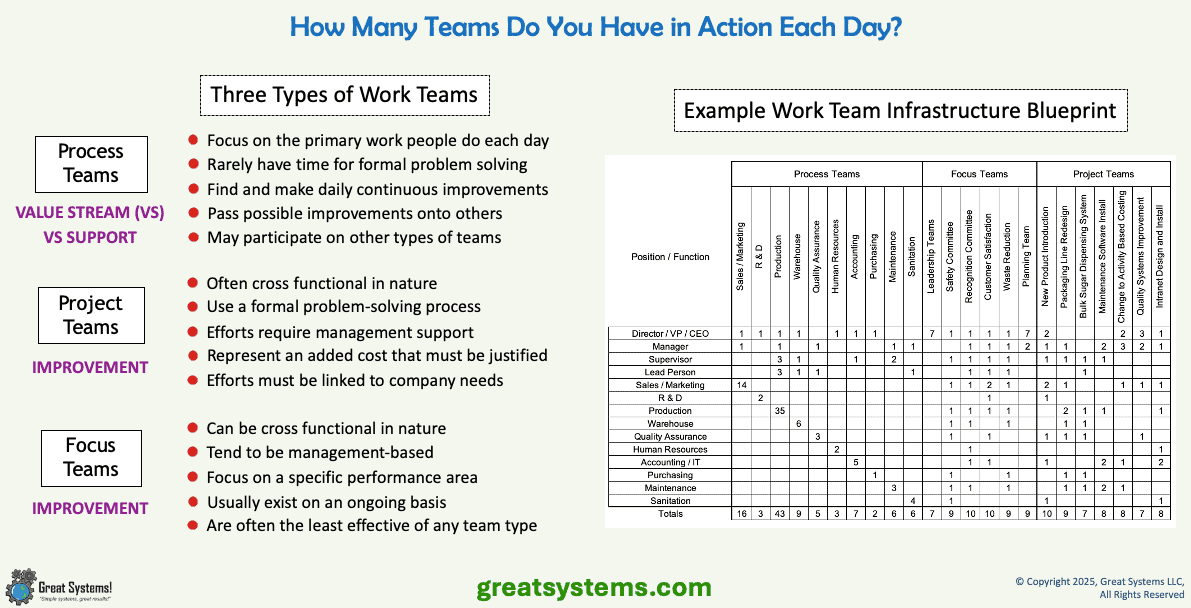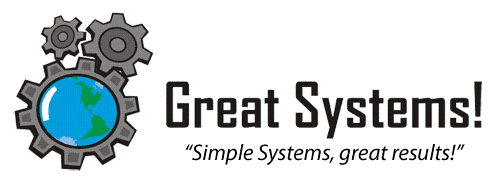Work Team Characteristics

What are Work Team Characteristics?
Work team characteristics include team size, makeup, focus, and meeting frequency. What work team characteristics do the different types of process, project, and improvement work teams possess in a high-performance workplace? How many different types of work teams do you have on the job?
Multiple work team characteristics help define the three common types of teams I share here. Plus, I summarize the most common characteristics one might find. However, I want to look at work from a NextGen perspective. What teams must be effective to support customer and stakeholder expectations?
Multiple work team characteristics help define the three common types of teams I share here. Plus, I summarize the most common characteristics one might find. However, I want to look at work from a NextGen perspective. What teams must be effective to support customer and stakeholder expectations?
Your Value Streams Define Your Core Work Teams
All organizations have at least one value stream, as their mission is to provide a product or service. The typical value stream is made up of at least three work processes. However, in a sole proprietor small business, one person executes all such processes.
First, process inputs must be collected from suppliers, such as materials or information. Then, the value stream converts those inputs into a product or service. Finally, this process output is delivered to the customer.
In turn, at least three PROCESS work teams work to provide that good or service. Keep in mind each 'team' could be as small as 1-2 people, with the same 1-2 people serving on each team. Define your value streams first. Then, define the processes that make up each value stream.
Typically, hourly staff spend 90% or more of their work time on this type of process work team. 'Working' supervisors also spend a significant portion of the work time in this way. However, it is more effective to shift formal leader time investments towards improvement when possible.
First, process inputs must be collected from suppliers, such as materials or information. Then, the value stream converts those inputs into a product or service. Finally, this process output is delivered to the customer.
In turn, at least three PROCESS work teams work to provide that good or service. Keep in mind each 'team' could be as small as 1-2 people, with the same 1-2 people serving on each team. Define your value streams first. Then, define the processes that make up each value stream.
Typically, hourly staff spend 90% or more of their work time on this type of process work team. 'Working' supervisors also spend a significant portion of the work time in this way. However, it is more effective to shift formal leader time investments towards improvement when possible.
There is a finite number of teams that a given organization either needs or can effectively support. Usually, the number of teams that can be effectively supported is much lower than the number of teams that an organization needs to successfully address its short and long-term strategies.
WATCH over 50 kaizen and workplace health improvement videos on my Great Systems YouTube channel.
WATCH over 50 kaizen and workplace health improvement videos on my Great Systems YouTube channel.
What Type of PROCESS Work Teams Do You Have?
Each year, IndustryWeek magazine issues a Best Plants Statistical Profile. Work team use is one of the key attributes of their annual 'Best Plant' award recipients. Also, the publication provides three operational definitions for work teams.
Natural work team: A team of employees, often hourly personnel, who share a common workspace and have responsibility for a particular process or process segment. Their direction to work is similar from an outcome perspective.
Empowered natural work teams: These work teams share a common workspace and/or responsibility for a particular process or process segment. Typically, such teams have clearly defined goals and objectives that relate to day-to-day production activities. Empowered activities might include quality assurance and meeting production schedules. Plus, work teams may have authority to plan and implement process improvements. Unlike self-directed teams, empowered work teams typically do not assume traditional "supervisory" roles and provide direction to work.
Self-directed natural work teams: These autonomous teams consist of employees who perform activities previously reserved for supervision. These work teams share a common workspace and/or responsibility for a particular process or process segment. Typically, such teams have authority for day-to-day production activities and many supervisory responsibilities.
Such responsibilities might include job assignment, production scheduling, and equipment maintenance. Other activities might include materials acquisition, training, quality assurance, performance review, and customer service. These groups are synonymous with "self-managed" work teams. All self-directed work teams are empowered.
Natural work team: A team of employees, often hourly personnel, who share a common workspace and have responsibility for a particular process or process segment. Their direction to work is similar from an outcome perspective.
Empowered natural work teams: These work teams share a common workspace and/or responsibility for a particular process or process segment. Typically, such teams have clearly defined goals and objectives that relate to day-to-day production activities. Empowered activities might include quality assurance and meeting production schedules. Plus, work teams may have authority to plan and implement process improvements. Unlike self-directed teams, empowered work teams typically do not assume traditional "supervisory" roles and provide direction to work.
Self-directed natural work teams: These autonomous teams consist of employees who perform activities previously reserved for supervision. These work teams share a common workspace and/or responsibility for a particular process or process segment. Typically, such teams have authority for day-to-day production activities and many supervisory responsibilities.
Such responsibilities might include job assignment, production scheduling, and equipment maintenance. Other activities might include materials acquisition, training, quality assurance, performance review, and customer service. These groups are synonymous with "self-managed" work teams. All self-directed work teams are empowered.
What is an IMPROVEMENT Work Team?
Many organizations use formal improvement teams to manage and improve performance. Two such team types are common - FOCUS improvement work teams (committees and other cross-functional groups) and PROJECT improvement work teams.
Typically, close to 100% of salaried staff work time is spent one or more improvement teams of some type. However, in a small workplace, the small number of salaried staff belong to all three types of work teams.
High performance companies allocate a higher percentage of hourly staff time to 'away from work' activities for improvement team support. If this time is put to effective use, such investments will accelerate a site's process improvement rate. Plus, improvement team engagement success drives the adoption of similar work practices in the daily work area.
Typically, close to 100% of salaried staff work time is spent one or more improvement teams of some type. However, in a small workplace, the small number of salaried staff belong to all three types of work teams.
High performance companies allocate a higher percentage of hourly staff time to 'away from work' activities for improvement team support. If this time is put to effective use, such investments will accelerate a site's process improvement rate. Plus, improvement team engagement success drives the adoption of similar work practices in the daily work area.
Work Team Design Drives Kaizen and Operational Excellence
How leaders define work team responsibilities affects the effective span of control ratio (people per supervisor). Span of control is a key operational parameter that leaders must optimize. All too often, the job design requires a leader to devote too much time to personnel problem resolution instead of process improvement. In turn, leaders unintentionally constrain the rate of organizational improvement.
Plus, if excessive turnover rates exist, we only magnify this 'lack of time for improvement' problem. How much time do you design into the jobs of EACH staff member? Collectively, how much time each day do you set aside for change support, personnel development, and workforce engagement?
How Much Work Time Do You Budget for Kaizen Each Day?
Most organizations waste time each day that could be spent on process and work systems improvement. Work team job design determines a location's rate of change. It is simple math, really. If only a few jobs include time for improvement work, the rate of change will be slow.
Best practice is to budget 10% of each staff member's weekly time for formal kaizen (continuous improvement) efforts. This amounts to 4 hours per week in a 40-hour week. Examples of formal kaizen time investment include daily huddles, monthly refresher training, and giving project feedback via social media. Ideally, teams use a portion of this time for formal waste reduction efforts.
Plus, if excessive turnover rates exist, we only magnify this 'lack of time for improvement' problem. How much time do you design into the jobs of EACH staff member? Collectively, how much time each day do you set aside for change support, personnel development, and workforce engagement?
How Much Work Time Do You Budget for Kaizen Each Day?
Most organizations waste time each day that could be spent on process and work systems improvement. Work team job design determines a location's rate of change. It is simple math, really. If only a few jobs include time for improvement work, the rate of change will be slow.
Best practice is to budget 10% of each staff member's weekly time for formal kaizen (continuous improvement) efforts. This amounts to 4 hours per week in a 40-hour week. Examples of formal kaizen time investment include daily huddles, monthly refresher training, and giving project feedback via social media. Ideally, teams use a portion of this time for formal waste reduction efforts.
Are Your PROCESS Work Teams Unintentionally Self-Directed?
Self-directed process work teams are an advanced form of the natural work groups all organizations have. Ideally, leaders train team members to effectively assume roles that other groups traditionally provided, such as Maintenance or Quality.
However, in today's workplace, the common error is to consider teams as 'self directed' before effective 'self-direction' skills are in place.
Most often, this occurs when the supervisory span of control ratio becomes too large (the number of people who report to a leader). However, such a shift is usually not intentional.
Most leaders want to manage and control overhead costs as a goal. In turn, they try to minimize supervisory headcount.
Unfortunately, there are many hidden costs that come as this ratio climbs above a level of 4 or 5 direct reports per leader.
However, in today's workplace, the common error is to consider teams as 'self directed' before effective 'self-direction' skills are in place.
Most often, this occurs when the supervisory span of control ratio becomes too large (the number of people who report to a leader). However, such a shift is usually not intentional.
Most leaders want to manage and control overhead costs as a goal. In turn, they try to minimize supervisory headcount.
Unfortunately, there are many hidden costs that come as this ratio climbs above a level of 4 or 5 direct reports per leader.

LISTEN NOW to my "Too Many Teams, Too Little Team Effectiveness' Real Life Work podcast!
PROCESS Work Team Characteristics
The primary goal of process work team members is to support daily value stream and support process performance. These activities take place in the everyday workplace.
When process work team members assume more non-traditional work team roles, individual and team time must be spent AWAY from the everyday workplace to perform these roles. Work team meetings serve as the primary forum for such activity.
Here are some example PROCESS work team characteristics:
* A PROCESS work team is a group of employees that meets regularly to:
* Share information on “state of the business” topics”
* Receive feedback related to the work team’s performance against key measures
* Propose ideas for improvement and get updates on existing projects
* Reinforce practices related to safety, quality, productivity, and customer satisfaction
* Evaluate and provide input on possible changes that would affect them or their work
* Interface with members of other teams and members of management
Factors that influence a PROCESS work team’s makeup (size, membership, and stability) include:
* The physical location of the work an individual performs
* The type of job being performed
* Similarities in work schedules
* A mandatory need to participate if continuous improvement is to occur
When process work team members assume more non-traditional work team roles, individual and team time must be spent AWAY from the everyday workplace to perform these roles. Work team meetings serve as the primary forum for such activity.
Here are some example PROCESS work team characteristics:
* A PROCESS work team is a group of employees that meets regularly to:
* Share information on “state of the business” topics”
* Receive feedback related to the work team’s performance against key measures
* Propose ideas for improvement and get updates on existing projects
* Reinforce practices related to safety, quality, productivity, and customer satisfaction
* Evaluate and provide input on possible changes that would affect them or their work
* Interface with members of other teams and members of management
Factors that influence a PROCESS work team’s makeup (size, membership, and stability) include:
* The physical location of the work an individual performs
* The type of job being performed
* Similarities in work schedules
* A mandatory need to participate if continuous improvement is to occur
PROCESS Work Team Meeting Characteristics
Process work team meeting frequency options include:
* Once per month for approximately one hour
* Twice a month for twenty to thirty minutes each time
* Weekly for 15 to 30 minutes per meeting
* Daily pre-job planning meetings at start of shift
More frequent process work team meetings help teams:
* Maintain a focus on the overall status of the business and day-to-day performance
* Align individual and team efforts with the organization’s mission, goals, and objectives
* Collaborate for idea generation, problem solving, and improvement proposals
Process work team meeting location and timing possibilities include:
* A meeting room if a quiet or multi-resource location is desired
* The work area if a particular problem is being discussed, to stay informal, or to save time
* At the beginning or end of each shift to avoid workflow interruptions
* Once per month for approximately one hour
* Twice a month for twenty to thirty minutes each time
* Weekly for 15 to 30 minutes per meeting
* Daily pre-job planning meetings at start of shift
More frequent process work team meetings help teams:
* Maintain a focus on the overall status of the business and day-to-day performance
* Align individual and team efforts with the organization’s mission, goals, and objectives
* Collaborate for idea generation, problem solving, and improvement proposals
Process work team meeting location and timing possibilities include:
* A meeting room if a quiet or multi-resource location is desired
* The work area if a particular problem is being discussed, to stay informal, or to save time
* At the beginning or end of each shift to avoid workflow interruptions
PROCESS Work Team Skill Characteristics
Basic PROCESS work team skills include:
* A desire for and understanding of continuous improvement and quality
* Knowledge of the work area and the needs of internal and external customers
* A basic awareness of communication and decision-making approaches
* The ability to interpret charts and graphs
* More advanced team, leader, and quality skills in some cases
Over time, as the process work team matures, possible changes include:
* A transition in process team leadership from supervisor to lead person
* Possible team leadership rotation between team members
* Growth in information sophistication and understanding
* Improvements in communication and cooperative problem solving
* Faster resolution of needs and a longer term, more focused team orientation
* Possible peer review of performance and involvement in other personnel issues
* A desire for and understanding of continuous improvement and quality
* Knowledge of the work area and the needs of internal and external customers
* A basic awareness of communication and decision-making approaches
* The ability to interpret charts and graphs
* More advanced team, leader, and quality skills in some cases
Over time, as the process work team matures, possible changes include:
* A transition in process team leadership from supervisor to lead person
* Possible team leadership rotation between team members
* Growth in information sophistication and understanding
* Improvements in communication and cooperative problem solving
* Faster resolution of needs and a longer term, more focused team orientation
* Possible peer review of performance and involvement in other personnel issues
Things to Avoid with PROCESS Work Teams
Process work team meetings are NOT a forum to:
* Work on problems outside of the team’s work area
* Use lengthy problem solving exercises or develop projects
* Deliver formal training content over thirty minutes in length
* Provide non-constructive criticism, one way communication, or give orders
* Resolve issues that relate to existing labor agreements
Possible process work team effectiveness constraints include:
* How to find time to meet as a team and not adversely impact customer service
* Supervisors who do not have the skills for, or are comfortable with, team facilitation
* Team members that fail to learn about how team dynamics work and their role in improvement
* Not providing the team with regular, consistent support information and data
How many process work teams do you have in action each day? To effectively answer this question, you should first answer "How many processes do you own question. Once you have done that, you can then look at how many processes each process work team owns.
About Kevin and Great Systems
Continuous Improvement and OPEX Coaching
Ask Questions or Request Assistance
* Work on problems outside of the team’s work area
* Use lengthy problem solving exercises or develop projects
* Deliver formal training content over thirty minutes in length
* Provide non-constructive criticism, one way communication, or give orders
* Resolve issues that relate to existing labor agreements
Possible process work team effectiveness constraints include:
* How to find time to meet as a team and not adversely impact customer service
* Supervisors who do not have the skills for, or are comfortable with, team facilitation
* Team members that fail to learn about how team dynamics work and their role in improvement
* Not providing the team with regular, consistent support information and data
How many process work teams do you have in action each day? To effectively answer this question, you should first answer "How many processes do you own question. Once you have done that, you can then look at how many processes each process work team owns.
About Kevin and Great Systems
Continuous Improvement and OPEX Coaching
Ask Questions or Request Assistance

